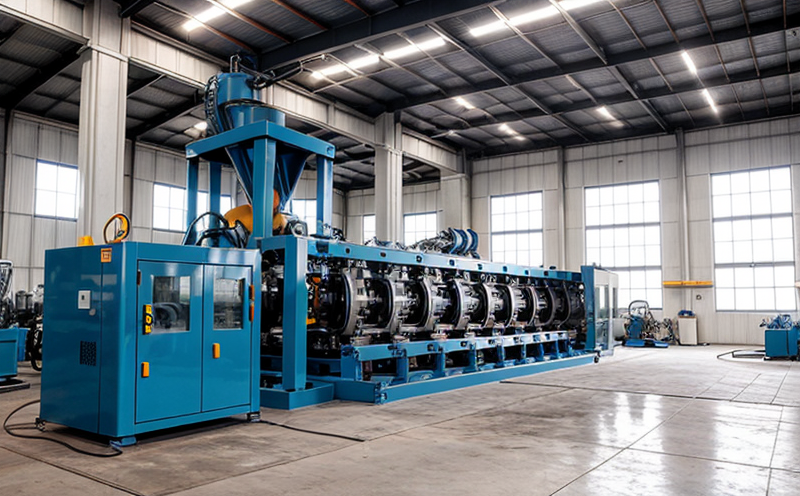EN 12644 Safety Requirements for Machinery Testing
The CEN standard EN 12644 specifies the safety requirements that need to be met by machinery to ensure worker and bystander safety during operation, maintenance, and servicing. This comprehensive document covers a wide range of machinery types, including but not limited to textile machinery, woodworking machines, metalworking equipment, conveyors, and packaging machinery.
The standard aims to prevent accidents caused by hazardous movements or states of the machine, as well as those associated with the machine’s environment. It addresses potential risks such as entanglement, crushing, cutting, shearing, and electrical hazards. The scope includes not only new machines but also used ones being reintroduced into service.
EN 12644 is structured around several key principles:
- Safety analysis: Identification of potential risks involved with the machine
- Design and construction: Ensuring that the design and materials used comply with safety requirements
- Operation, maintenance, and servicing: Guidelines for safe operation by trained personnel
- Environmental aspects: Considering how the machine interacts with its surroundings
The standard is applicable to all types of machinery covered in ISO 12100-1. It requires manufacturers to provide documentation that demonstrates compliance with these safety requirements.
Real-world Application: Compliance with EN 12644 can be demonstrated through rigorous testing and analysis, which involves several stages:
- Identification of hazards using risk assessment methods
- Evaluation of risks based on severity and frequency
- Determination of control measures needed to minimize or eliminate identified risks
- Implementation of these controls during design and manufacturing
- Verification through testing and validation post-production
The testing process typically involves:
- Instrumentation setup for monitoring critical parameters such as speed, force, torque, temperature, etc.
- Specimen preparation to represent real-world operating conditions accurately.
- Data collection and analysis using advanced software tools.
The resulting reports provide detailed insights into the machine’s compliance with EN 12644 requirements. These documents are crucial for regulatory approval processes, insurance purposes, and internal quality assurance.
| Stage | Main Activities | Tools Used |
|---|---|---|
| Risk Identification | Conducting hazard analysis using checklists and interviews with operators | Hazard Analysis Checklists, Interview Guides |
| Risk Assessment | Evaluating likelihood and severity of identified hazards | Risk Matrix Software |
| Control Measures Implementation | Designing and specifying safety features like guards, interlocks, etc. | 3D CAD Modeling Software |
| Testing | Performing tests under simulated operational conditions | Instrumentation Systems, Test Fixtures |
The standard also mandates regular inspections and maintenance to ensure ongoing safety compliance. This includes periodic re-assessment of risks based on changes in the machine’s usage patterns or technological advancements.
For machinery designed for specific industries, additional sector-specific regulations may apply alongside EN 12644. For instance, textile machinery might also need compliance with ISO standards related to material handling and finishing equipment.
Benefits
- Enhanced Safety: Reduces the risk of accidents during operation, maintenance, and servicing.
- Regulatory Compliance: Ensures that machinery meets international safety standards, facilitating smoother market entry in multiple jurisdictions.
- Improved Reputation: Demonstrates a commitment to quality and worker safety, enhancing brand reputation among stakeholders.
- Cost Savings: By preventing accidents, companies avoid costly lawsuits, medical expenses, and downtime due to machinery failures.
- Innovation Facilitation: Compliance with EN 12644 encourages continuous improvement in machine design and safety features.
- Customer Trust: Meeting international standards builds trust among customers who value safety in the products they purchase.
International Acceptance and Recognition
The EN 12644 standard is widely recognized across Europe and beyond. Its acceptance by various industries ensures that machinery produced in compliance with this standard can be sold globally without additional modifications.
Many countries outside the European Union have adopted or are working towards adopting similar safety standards for machinery. This includes North America, where ANSI B11 series standards serve a role analogous to EN 12644. In Asia-Pacific regions like China and Japan, national equivalents of this standard also exist.
Compliance with EN 12644 is not only beneficial for manufacturers; it also offers significant advantages for end-users:
- Increased confidence in purchasing safe equipment
- Potential for reduced insurance premiums due to lower accident risk
- Enhanced productivity through fewer disruptions caused by safety incidents
In conclusion, adhering to EN 12644 is essential for any manufacturer aiming to produce reliable and safe machinery. It provides a framework that ensures both product quality and worker safety.
Use Cases and Application Examples
| Application Example | Description | Safety Concerns Addressed |
|---|---|---|
| Metalworking Machines (e.g., Lathe) | Processing of metal parts for various industries. | Preventing entanglement, crushing, and over-speed incidents. |
| Woodworking Machinery (e.g., Band Saw) | Cutting wood into specific shapes and sizes. | Avoiding saw blade kickback and ensuring proper guarding. |
| Automated systems for packaging goods in various formats. | Preventing jams that could lead to operator injuries. |
| Application Example | Description | Safety Concerns Addressed |
|---|---|---|
| Moving materials through factories and warehouses. | Ensuring proper guarding at transfer points to prevent falls and entanglements. | |
| Automated systems for packaging goods in various formats. | Preventing jams that could lead to operator injuries. | |
| Performing complex tasks within manufacturing environments. | Ensuring safe operation around human workers and preventing accidental contact. |





